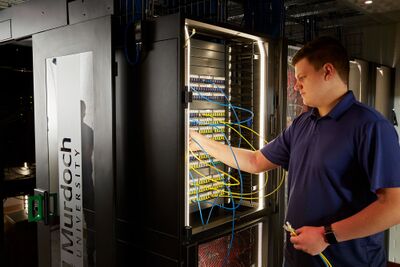Difference between revisions of "Main Page"
Jump to navigation
Jump to search
| Line 76: | Line 76: | ||
*[[Linux Essentials]] - Week 3 -> Fork from [[Ubuntu_Desktop_Familiarisation]] Cli only and emphasise some IoT embedded aspects | *[[Linux Essentials]] - Week 3 -> Fork from [[Ubuntu_Desktop_Familiarisation]] Cli only and emphasise some IoT embedded aspects | ||
*[[Install Raspbian get connected and basic networking]] - Week 4 -> Install Rasbian on an SD card and connect to the internet. Get SSH access from student VM to Raspberry Pi. | *[[Install Raspbian get connected and basic networking]] - Week 4 -> Install Rasbian on an SD card and connect to the internet. Get SSH access from student VM to Raspberry Pi. | ||
| − | *[[Basic LEDs Sensors and Raspbian]] - Week 5 -> Basic breadboarding then integrate with Pi. | + | *[[Basic LEDs Sensors and Raspbian]] - Week 5 -> Basic breadboarding then integrate with Pi. Sense a variable, turn on an LED with BASH. |
*[[Presentation Week 1]] - Week 6 - > Students do 6 minute pitch presentation in class | *[[Presentation Week 1]] - Week 6 - > Students do 6 minute pitch presentation in class | ||
*[[Relays and Rasbian]] - Week 7 - Get Raspbian to turn on/off power to an external appliance | *[[Relays and Rasbian]] - Week 7 - Get Raspbian to turn on/off power to an external appliance | ||
Revision as of 00:56, 21 May 2020
This is the public-facing main page of the Murdoch University Cyber Security & Networking Wiki. Here you can find information about The Lab Environment and our Teaching Philosophy. We teach applied Cyber Security & Networking content. Here we have made the provided the activities that we deliver to the community as well as some lab content from a number of units in this area.
The Wiki environment that you see here is also the method that we use to write teaching materials and the majority of the users of this site are students studying our units.
Contents
Outreach Content
- The Lab Environment and our Teaching Philosophy
- Examining Memory Dumps with Volatility
- Internet of Things Outreach
- Internet of Things Lighting
- Internte of Things Open Day
- Crack the Code
- Cyber Security Penetration Testing Activity
Server Environments and Architectures
- Obtaining a Linux Environment
- Ubuntu Desktop Familiarisation
- Linux Services
- Total Cost of Ownership
- Data Networking & Operation Centre Discovery
- Linux Permissions
- Amazon EC2 Web Services
- DNS
- DNS via Route53
- Obtaining a Digital Certificate from Lets Encrypt
- Scripting Linux Server Functions
- Windows Server in EC2 Intro
- Windows Server Virtualisation
- Windows Server Scripting
Advanced Wireless
- Your own mobile Linux box
- Broadband CPE Scenarios with Mikrotik and DD-WRT
- SSH Keys et al
- RTS/CTS and Network Analysis using Wireshark
- Performance Tuning
- Roaming
- Viewing the physical layer using WiSpy
- SSID Hiding and MAC Filtering
- WEP Cracking
- WPA Cracking
- Wireless Bridging
- Virtual Interfaces
- Enterprise Authentication using FreeRADIUS
- Network Analysis Lab
- Network Forensics with Wireshark
- Forensic Examination of Packet Captures
- GPON PPPoE
- Wireguard VPN
- Open VPN
- Splunk
Internet of Things
IoT099 Need some thoughts on maybe just two very basic activities, or do we simply use the Cisco pdfs's?
- placeholder - IFTT integration? QR-Code, Bluetooth between laptop and phone
- Ideas That Drive You
IoT101 and IoT501
- Unit Introduction - Week 1 -> Just descriptive, how we will work where to order the resources
- Installing and using a Linux VM - Week 2 -> Fork from Obtaining_a_Linux_Environment using a CLI only installer
- Linux Essentials - Week 3 -> Fork from Ubuntu_Desktop_Familiarisation Cli only and emphasise some IoT embedded aspects
- Install Raspbian get connected and basic networking - Week 4 -> Install Rasbian on an SD card and connect to the internet. Get SSH access from student VM to Raspberry Pi.
- Basic LEDs Sensors and Raspbian - Week 5 -> Basic breadboarding then integrate with Pi. Sense a variable, turn on an LED with BASH.
- Presentation Week 1 - Week 6 - > Students do 6 minute pitch presentation in class
- Relays and Rasbian - Week 7 - Get Raspbian to turn on/off power to an external appliance
- BluetoothLE WiFi and Raspian - Week 8 - Some Networking through the Raspberry Pi lens
- NFC - Week 9
- If This Then That - Week 10 - Sense a variable and send message to a phone using ITTT
- Alexa Siri Google Home - Week 11 - Integrate with voice command via smartphone triggers change in Raspberry Pi
- Final Presentations - Week 12 - Nothing to do - grading
- Final Presentations - Week 13 - Nothing to do - grading
EVE - Network Emulator
- Configuring IP addresses with EVE virtualPC
- Spanning Tree Default Behaviour
- Spanning Tree Manipulating the root bridge
- Multiple Spanning Tree
- EVE OSPF Routing
- OSPF Multi-area and Route Summarisation
- EVE_Basic_ACLs
- EVE_ACL_Challenge
- EVE_NAT

